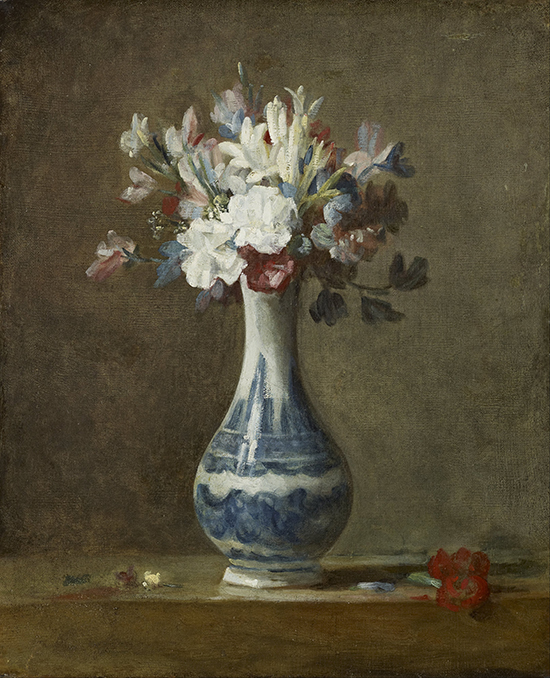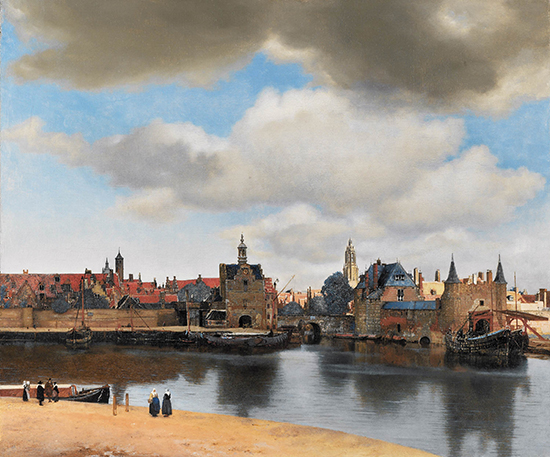Two Poems, after Vermeer and Chardin
Aspects of Light
Two Poems, after Vermeer and Chardin
The poems included in this project are ekphrastic by nature, taking their inspiration directly from paintings. Not incidentally, both of the paintings chosen relate in some way to the work of Marcel Proust—the first, Jan Vermeer’s View of Delft, recurs throughout La Recherche du Temps Perdu as a kind of template for the ideal work of art (and was one of Proust’s own favorite paintings1); the second is a still life by the French artist Jean-Baptiste-Siméon Chardin, a contemporary of Proust’s whose work was the subject of an early essay entitled “Chardin et Rembrandt.”2 I found in each an opportunity not only to further mine the ontological relationship between painting and poetry—both forms being essentially visual—but also to consider how artworks reify subjectivity in all its attendant complexity. In so doing I tried my best to pay particular attention to the senses, though in practice the process was, of course, slightly more intuitive.
With View of Delft, I looked to the poetry of Elizabeth Bishop, to her handling of sight and precise sense of rhythm. First and foremost in my mind was “At the Fishhouses”: I wanted to see if I could imitate, in a compressed form, the way in which Bishop leads the viewer through a scene, the path marked by both direction (“Up on the little slope behind the houses,” “Down at the water’s edge,”) and color (that iridescent silver which moves through benches, pots, masts, fish, flies, trees, and finally the water). In a similar manner, my poem traces the painting from the sky downward, using blue as a marker. “Paris, 7 A.M.” provided a more formal influence, notably the inconsistent rhyme scheme and repetition of imagery (the pigeons, the shapes).3
For the latter and lengthier poem, I attempted to draw from as many different poetic styles as possible. In the first section, the deliberate rhyme scheme and philosophical discourses ape both Wallace Stevens—I specifically held the last section of “Peter Quince at the Clavier” in my mind while writing—and, to a lesser extent, the T.S. Eliot of “Four Quartets.” 4, 5 I also employ, both here and in the third section, extra-textual quotes in the style of Marianne Moore; one is taken from the previously mentioned essay “Chardin et Rembrandt,” in which a twenty-four-year-old Proust articulates an embryonic version of the aesthetic philosophy he will go on to develop in the Recherche. (The full sentence reads: “We shall see that objects in themselves are nothing, being hollow orbits whose light is the play of expression, the gleam borrowed from beauty, the divine gaze.”) The second quotation is by the French philosopher Simone Weil, whose writings can, I think, be viewed through a lens of mysticism, and remind me of Moore’s references to the figures of Habakkuk and XY in her poem “The Past is Present.” [6.Moore, Marianne, and Heather Cass White. “The Past is Present.” New Collected Poems of Marianne Moore. Farrar, Straus and Giroux, New York, 2017.]
As for the second section, I again drew from Stevens, albeit obliquely. I direct most of my attention towards the musicality of the words, and the confusion of sense experiences implied by the “delectation of flowers.” Here, objects to be looked at are also objects to be consumed, an idea extending to the third section, first with the Simone Weil quotation and later on with the stanza that reads “Perhaps it is better to/quiet the hand, to glut/the ravenous eyes.” The third section in particular parodies Auden’s “this lunar beauty”: The stanzas move in descending order of lines (8, 8, 6, 4, 2) and deal with subject matter that hopefully speaks for itself.6
Only so much can be said when it comes to poetry, especially one’s own; but in general I would like to think that these two poems act as a kind of synthesis—whether conscious or unconscious—of all the poets discussed in Professor Lisa Goldfarb’s Interdisciplinary Seminar “Modern Poetry and the Senses.” My hope is that they may tell at least some of the truth, and tell it slant.
View of Delft (1660-1661)
by Jan Vermeer
First, the sky is coerced by a febrile hand,
dragged to the immediate end of the word:
A bit of sky, a skein of cloud (this woolly
greenish-grey), and all of a sudden
the spire of a church
exhorting itself churlishly into the light.
It drags you down to the water,
unfurls with the texture of
a rock, its origin,
until you are almost convinced
that the movement it acquires is its own.
Almost convinced that a bit of sky
of lightest, sweetest blue makes due
with a name.
But the selfsame sky which covers
the city like a mantel knows how to behave.
See the twin-faced scrim of coastline
skirting the boats, packed tight
so as not to flee; how the blue
scales up and then down in its
translation from
element to element—
The natural procedure of an unnatural law.
The buildings are likewise keenly placed,
each one delayed, spilling with
an orphaned light.
(This light I have seen in
other, less focused scenes.)
See the tensing of a stillness in between
their shapes, the blue, not yet obliterated
by the night.
Who can say by what discernment
such details came to pass, or
by what act of will?
The paint gossips, the colors sing.
And we make do with the slant of docks.
A Vase of Flowers (1750)
by Jean-Baptiste-Siméon-Chardin

1.
If “objects in themselves are nothing,”
Then why have I seen, among the sloughing
Of persons and days, the perfect (and petrified)
Form of a vase, capped with flowers?
Should there be a better way to assemble hours?
Thrust one’s hands in salt and sand
In hopes of fashioning a kind of clay?
Better to theorize truth and beauty
As arbiters of a lesser duty—
That is, to mark by rhythm or sign
The soul’s imperfect pantomime, and scrape
Away whatever is left to be scraped.
I can think of nothing better than a vase
To bear the fruits of withered days.
2.
Flowers, slumped and sighing
Beat their chests, make a display
Of going mad. Darkness spreads
About each pendant, ruffled head.
Somewhere, sighing, you prepare
A meal, lay out cutlery for delectation
Of flowers. The fire stirs.
The window gapes.
Side by side these flowers are
Almost gone. What have we done, have we
Forgotten the fire? Not quite: a ruse.
The night diffuses like a bruise.
3.
Yet somehow, Erinna
In her spinning
Spun a garland,
It smelled of ash
And half-whispered wantings.
To want, or if only to want, to look:
“Eternal beatitude is a state where
To look is to eat.”
Flowers remember.
And this picture, too,
Even as I look to you for
Confirmation, or a sign.
To console oneself with
A few pretty theories,
While wanting is a body
In need of time.
How should I want, then,
If I am less than a saint, or a poet?
If I am unprepared?
If the flowers, in their wanting,
Make a mockery of this, and know
Nothing, nothing at all?
Perhaps it is better to
Quiet the hand, to glut
The ravenous eyes. And
Better quicken the heart.
Even in my desperation
There is a kind of art.
- Specific quotes from Proust regarding the painting can be found in Gabrielle Townsend’s Proust’s Imaginary Museum: Reproductions and Reproduction in À la Recherche Du Temps Perdu.
- Proust, Marcel, and Jennie Feldman. Chardin and Rembrandt. David Zwirner Books, 2016.
- Bishop, Elizabeth. “At the Fishhouses” and “Paris, 7 A.M.” Complete Poems. Chatto & Windus, 2007.
- Stevens, Wallace, et al. “Peter Quince at the Clavier.” The Collected Poems of Wallace Stevens. Vintage Books, 2015.
- Eliot, T.S. Four Quartets. Mariner Books, Houghton Mifflin Harcourt, 1971.
- Auden, W.H., and E. Mendesson. “this lunar beauty.” Collected Poems. Faber, 1976.
